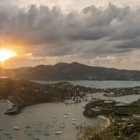
At one of the world’s most popular destinations for scuba diving, the Cayman Islands, there's sunken treasure unlikely to be found by amateur divers gliding past coral, marine life and shipwrecks. In the waters of the Caribbean, discovering that bounty – barrels of fine rum – would be like finding the proverbial needle in a haystack.
Editor's note: Please check the latest travel restrictions before planning any trip and always follow government advice.
The rum wasn’t lost at sea centuries ago. Sealed inside watertight bags, the barrels are deliberately placed precisely seven fathoms (42 ft) beneath the surface for two years. The unique aging technique provides boasting rights for the folks at Cayman Spirits Company, the island nation’s only distillery.
“The concept of agitation comes from a very old idea,” says Walker Romanica, co-owner of Cayman Spirits. “It comes from a time when people would make rum, put it on a ship and (later) realized the rum on the ship aged better than the same rum on shore, because the barrel was constantly being rocked by the waves.”

The power of agitation was also recognized by distiller Facundo Bacardi in the mid-1800s. According to Cayman Spirits’ other co-owner, Nelson Dilbert, Bacardi attributed the taste of his rum, now world-famous, to the vibration from trains rumbling past his warehouse, which was then located in Cuba. Bacardi is now made in the world’s largest rum distillery in Cataño, Puerto Rico.
“The agitation itself enhances the aging,” Dilbert says. “You’re getting the characteristics and the complexity of a much-longer-aged rum.”
While Cayman Spirits makes a variety of rums, Seven Fathoms is its super-premium product. A 750ml bottle sells for US$40 at the distillery. Even though it’s touted as a rum for sipping, not mixing, the novel aging process recently prompted Dilbert and Romanica to use Seven Fathoms in their newest product: rum-and-cola.
Located in an industrialized area of George Town on Grand Cayman, the largest and most-visited of the Cayman Islands, the distillery welcomes roughly 400 visitors each day. They come mostly from cruise ships and local tour operators. Independent travelers can book online.
The highlight of the US$15 tour is, of course, the tasting.

Dilbert’s son, Donovan Lumby, is in charge of the bar. He serves up snifters of the distillery’s various rums, culminating with ample samples of Seven Fathoms. Lumby shares with guests the rum’s unique, in-the-water aging process. He also explains that it’s produced using a blend of island-grown sugar cane and molasses, since Grand Cayman doesn’t grow enough cane to meet the distillery’s needs.
During the tastings, open to people 18 and older, people may detect hints of whiskey. That’s because Seven Fathoms is aged in recycled casks that once contained Kentucky bourbon.
As demand grows, so, too, does production. The distillery that produced its first batch of Seven Fathoms – a single bottle – 11 years ago, is now aging batch number 100 – far larger than the original one.
Divers aren’t likely to discover the barrels rocking back and forth more than 40 feet beneath the surface of the sea. Although the company has tried locations around the island, Dilbert said his preferred site is near the northernmost point of the island in an area known as West Bay. The Cayman Turtle Centre, where visitors can interact with the country’s unofficial mascot, the green sea turtle, is the nearest tourist attraction.
Romanica isn’t worried about hurricanes interfering with the aging process. He said the swell at seven fathoms wouldn’t be nearly as severe as on the surface.
“It really could be safer (in the water) than in the storehouse,” he says.
You might also like:
Conch, callaloo, cassava: a taste of the Cayman Islands
Alternative Caribbean: 6 unique experiences in the Cayman Islands
Seven unmissable dive sites in the Cayman Islands
Jay Jones traveled to the Cayman Islands with support from the Cayman Islands Department of Tourism. Lonely Planet contributors do not accept freebies in exchange for positive coverage.
Explore related stories










